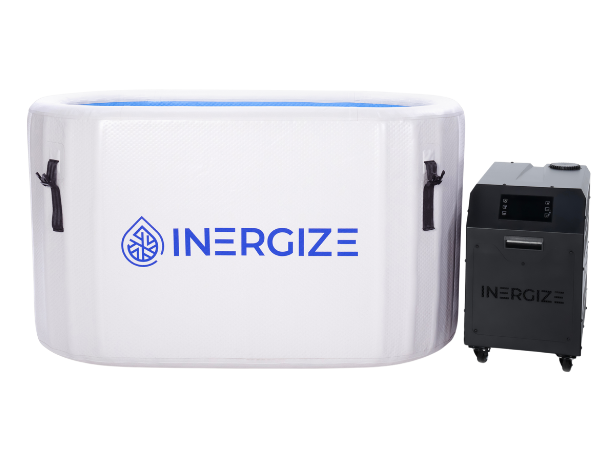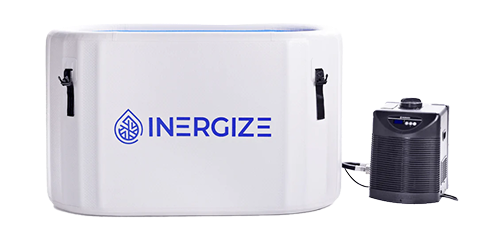Can Cold Plunges Improve Your Skin Elasticity?
What is the connection between cold plunges and skin elasticity, and can the centuries-old wellness practice also improve your skin? Let’s discuss the mechanisms, separate hype from facts, and show you how to use cold plunges safely if you enjoy the ritual in this blog post.
Cold Plunges and Skin Elasticity
Skin elasticity is your skin’s ability to stretch and snap back naturally. Collagen and elastin fibers, hydration, and the dermal matrix all contribute to this natural process. As we age, collagen breaks down and elasticity declines. Sun exposure and lifestyle also speed up that process.
Improving elasticity long-term usually requires changes at the dermal level (think collagen remodeling), not just surface effects. While the body can do this naturally, you have a role to play too in terms of what you eat, the products you apply to your skin, how you protect your skin and wellness routines. This is where cold plunging comes in.
What Cold Plunges Can Do to Your Skin (Right Away)

When you immerse yourself in cold water, your body triggers vasoconstriction. This is when your blood vessels at the skin surface narrow to conserve heat. This reduces local skin microcirculation and skin temperature, which is why skin can look tighter and less puffy for a short while.
As you rewarm, reactive vasodilation returns flow. These are temporary changes. Cold also calms inflamed tissue and reduces nerve conduction, which can decrease redness and soothe irritated skin. This process is similar to using a cool compress after a procedure.
Can Cold Plunges Increase Skin Elasticity Long-Term?
While the visible “tightness” you feel after a cold plunge is temporary, there is emerging evidence suggesting that consistent cold exposure may support skin elasticity in the long run. Here’s why:
Improved Circulation Cycles
Each cold plunge you take triggers vasoconstriction, followed by vasodilation once you warm up. Over time, these repeated cycles may strengthen microcirculation and oxygen delivery to skin tissues.
Better nutrient flow supports fibroblast activity (the cells responsible for collagen and elastin maintenance). Healthier fibroblasts mean your skin is more resilient and better able to retain elasticity.
Reduced Chronic Inflammation
Low-grade inflammation accelerates collagen breakdown and weakens the skin’s structural proteins. Cold plunging is well-documented to lower inflammatory markers in the body. As it calms your systemic inflammation, cold exposure could indirectly protect your collagen stores and slow the natural loss of elasticity that comes with aging.
Stress Regulation and Hormonal Balance
Cold plunges activate the parasympathetic nervous system and help regulate cortisol. Elevated cortisol has been linked to impaired skin barrier function and premature collagen loss. Cold plunges help in keeping stress hormones in check to create an internal environment that favors healthier, more elastic skin.
Potential Collagen Stimulation Through Hormesis
Hormesis is the concept that small, controlled stressors (like cold exposure) can trigger beneficial adaptive responses. With cold plunges, the stress may encourage the body to upregulate repair pathways. This includes collagen production as part of its adaptation to repeated environmental challenges.
The combination of improved circulation, reduced inflammation, better stress regulation, and adaptive repair does show that regular cold plunging could be a supportive practice for maintaining skin elasticity over time. However, it’s important we mention here that more studies on the relationship between skin health and regular cold-water immersion (CWI) and ice bathing are ongoing.
Strategies to Maximize Skin Elasticity with Cold Plunges

In the following table, you will find suggested cold plunging strategies aimed at maximizing benefits to skin health. Feel free to change and adapt them to your existing cold plunge protocol/routine.
|
Strategy |
Why it helps |
How to apply |
|
Consistency over intensity |
Repeated mild exposure trains circulation and repair pathways better than extreme, irregular plunges. |
Aim for 2 to 4 plunges per week, 2 to 3 minutes each. |
|
Pair with hydration & moisturization |
Cold can dehydrate skin; sealing in moisture supports elasticity. |
Moisturize immediately after plunges. |
|
Support with collagen-rich nutrition |
Cold stress may boost repair, but collagen availability matters. |
Include protein and vitamin C daily; consider collagen peptides. |
|
Time sessions smartly |
Morning plunges can reduce puffiness, while post-workout plunges may limit inflammation that damages collagen. |
Adjust timing to lifestyle goals. |
|
Avoid overexposure |
Excessive cold can dry and stress skin, undermining elasticity. |
Keep sessions brief and controlled. |
Risks And Who Should Be Careful with Cold Plunging
Cold plunging is a good wellness practice that has been around for centuries. However, it is not risk-free. Pay attention to the following safety guidelines when cold plunging for skin improvement:
Cold urticaria (hives triggered by cold): Hives, swelling, and in rare cases, severe reactions can occur after cold exposure. If you notice welts or itching with cold water, stop and speak to a clinician.
Raynaud’s phenomenon: You may experience exaggerated vessel constriction in fingers and toes; cold plunges may trigger numbness, pain, or color changes. If you have Raynaud’s, minimize cold exposure to extremities and get personalized advice from your doctor.
Dryness and barrier stress: Cold environments can strip moisture. Pair plunges with gentle cleansing and immediate moisturization to protect the barrier.
In Conclusion
Cold plunges can make your skin look tighter right after a dip, thanks to vasoconstriction and reduced swelling. That’s great for a quick refresh. If your goal is lasting elasticity, include sun protection, smart topicals, nutrition, and consistent skincare in your wellness routine.
Ready to add a safe, at-home plunge to your routine? Try our best-selling cold plunge tub today for consistent sessions you can control.
FAQ
Do Cold Plunges Actually Tighten Skin?
Yes. Cold causes vasoconstriction, which reduces puffiness and makes skin look a bit tighter. The effect fades as you rewarm.
Can Cold Plunges Build Collagen Like Retinoids Do?
Device-based “focused cold therapy” has improved wrinkles in studies. For everyday routines, SPF, retinoids (if suitable), and possibly collagen supplements are necessary for elasticity.
Is Cold Good for Sensitive or Acne-Prone Skin?
Cold can calm redness and swelling, which some people like. But very cold water can aggravate reactive skin or conditions like cold urticaria. Start gently, keep sessions short, and moisturize afterward. If you experience welts, itching, or numb, color-changing fingers or toes, stop and talk to a clinician.






